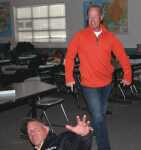School training focuses on 'active shooter' scenario

The two men and a woman walked into Mountain Home Junior High School last week, pulled out their guns, fired into the office and then ran toward the crowded classrooms.
The sound of shots rang out in the hallway. Over the intercom, an ominous announcement was made. "We have an active shooting in the building, repeat, an active shooter is in the building."
It was all part of a drill, a training exercise designed for teachers and administrators during their "no school" professional development day that had been put together by police officers Melanie Broughton and Stan Winings, with help from other members of the Mountain Home Police Department.
Almost every teacher in the district took part.
In the morning, they learned about what others across the country have learned about school shootings. "We really don't call them active shooters," Broughton said. "What they really are are active killers. Their goal is to kill as many people as they can.
"Our goal is to prevent that, or at least hold the casualties to a minimum," she said.
"We try and encourage people to think outside the box," Winings added. "You want to do whatever you can to avoid being a victim."
The two officers stressed three basic rules to the teachers.
Run if you can. Get out of the building and get to a safe spot.
If you can't run, hide. Find a way to barricade and block the doors to a classroom so the shooters can't easily get inside. They know law enforcement will be arriving quickly. They don't have time to waste trying to break through a barricade.
Finally, if you can't run and you can't hide, as a last resort, fight back. "Don't be a willing victim," Winings repeated.
The morning session, attended by almost every teacher in the district, discussed options and taught the teachers about how law enforcement would respond. Before Columbine, officers usually attempted to secure a perimeter and then carefully enter a building, track down and neutralize the shooters. Since then, officers are now trained to get into the building as quickly as possible and take down anyone with a gun in their hands.
"There may be wounded in the hallways or the classrooms," Wining said. "But our job is to get the shooters. We're not going to stop to help someone who's been shot. So don't try and slow us down by grabbing us and insisting we help. We're going for the guys doing the shooting, and once we've neutralized them, then the EMTs can come in and do their work.
"And whatever you do, obey any instruction by a police officer instantly," he told the teachers.
At least once a year, usually in the summer when there are no students around and just a handful of volunteers to help, local law enforcement agencies hold "active shooter" exercises in the schools, training to enter and clear those schools as quickly as possible. They work with the districts in helping develop and coordinate emergency response plans.
But this was the first time all the districts' teachers were actively involved in a training session.
They were divided into six classrooms scattered throughout the junior high. Some served as shooters firing water pistols or handguns with blanks so teachers could recognize the sound of gunshots in a hallway. Some played the role of cops. Many of the real cops and COPs at the exercise played the role of victims.
Throughout the afternoon they practiced several exercises, trying each of the three basic options. Then they had an "open" exercise where they made their own choices.
Some ran when they had a chance. In room 127, they built a barricade of desks against the door, covered the door window with paper, and used their belts to tie the door shut. No shooter got in the room.
In the hallways, Dan Day, the school psychologist, wrestled a shooter to the ground. "I guess I wasn't supposed to do that," the diminutive Day said.
But it worked.
Supt. Tim McMurtrey said the exercise taught his teachers and administrators a lot. In fact, they planned on making some modifications to their emergency plan for to reflect what they learned. Sometimes, it was just little things. It was difficult to tell on the video monitoring systems in the school which stairwell they were looking at. "A number, or some paint on the railing, and we'd be able to tell instantly," McMurtrey said.
Knowing where a shooter is helps not only law enforcement, but also the teachers, who then can decide if it's best to run from or to hide in their specific location.
Mainly, it got the teachers thinking about what they would do, and what options they had, said Broughton. "That was the main goal of the exercise.
"We weren't trying to attack the district's plan or anything. They have a good plan. But now they (the teachers) are thinking about it. God forbid, if it ever happened," she said, "they'd have a better idea what to do."
There was no question the teachers took it seriously. The questions they asked and comments they made during the exercise debriefings showed they understood both the possibilities and limitations they faced in their own buildings. The different age groups, for example, would make a huge difference in the options available to teachers to save their students. Many of the teachers asked to have another round of exercises in their own buildings, since each school has certain unique characteristics. McMurtrey said such a follow-up was highly likely.
"It was good training for us. We learned a lot," he said.
The goal of the exercise," Broughton noted, "was to get them to put on their thinking caps and think about what they could do.
"We all have a common goal," she said of the teachers and police -- "to protect the students."
